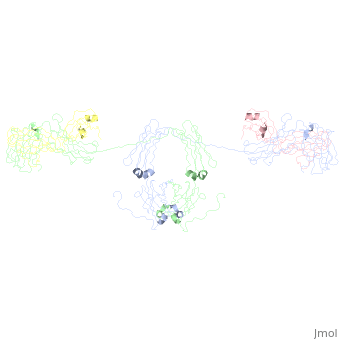1iga: Difference between revisions
Jump to navigation
Jump to search
No edit summary |
No edit summary |
||
| Line 4: | Line 4: | ||
== Structural highlights == | == Structural highlights == | ||
<table><tr><td colspan='2'>[[1iga]] is a 4 chain structure with sequence from [https://en.wikipedia.org/wiki/Homo_sapiens Homo sapiens]. Full crystallographic information is available from [http://oca.weizmann.ac.il/oca-bin/ocashort?id=1IGA OCA]. For a <b>guided tour on the structure components</b> use [https://proteopedia.org/fgij/fg.htm?mol=1IGA FirstGlance]. <br> | <table><tr><td colspan='2'>[[1iga]] is a 4 chain structure with sequence from [https://en.wikipedia.org/wiki/Homo_sapiens Homo sapiens]. Full crystallographic information is available from [http://oca.weizmann.ac.il/oca-bin/ocashort?id=1IGA OCA]. For a <b>guided tour on the structure components</b> use [https://proteopedia.org/fgij/fg.htm?mol=1IGA FirstGlance]. <br> | ||
</td></tr><tr id='resources'><td class="sblockLbl"><b>Resources:</b></td><td class="sblockDat"><span class='plainlinks'>[https://proteopedia.org/fgij/fg.htm?mol=1iga FirstGlance], [http://oca.weizmann.ac.il/oca-bin/ocaids?id=1iga OCA], [https://pdbe.org/1iga PDBe], [https://www.rcsb.org/pdb/explore.do?structureId=1iga RCSB], [https://www.ebi.ac.uk/pdbsum/1iga PDBsum], [https://prosat.h-its.org/prosat/prosatexe?pdbcode=1iga ProSAT]</span></td></tr> | </td></tr><tr id='method'><td class="sblockLbl"><b>[[Empirical_models|Method:]]</b></td><td class="sblockDat" id="methodDat">X-ray solution scattering</td></tr> | ||
<tr id='resources'><td class="sblockLbl"><b>Resources:</b></td><td class="sblockDat"><span class='plainlinks'>[https://proteopedia.org/fgij/fg.htm?mol=1iga FirstGlance], [http://oca.weizmann.ac.il/oca-bin/ocaids?id=1iga OCA], [https://pdbe.org/1iga PDBe], [https://www.rcsb.org/pdb/explore.do?structureId=1iga RCSB], [https://www.ebi.ac.uk/pdbsum/1iga PDBsum], [https://prosat.h-its.org/prosat/prosatexe?pdbcode=1iga ProSAT]</span></td></tr> | |||
</table> | </table> | ||
== Disease == | == Disease == | ||
[https://www.uniprot.org/uniprot/IGHA1_HUMAN IGHA1_HUMAN] Note=A chromosomal aberration involving IGHA1 is found in multiple myeloma (MM) cell lines. Translocation t(1;14)(q21;q32) that forms a FCRL4-IGHA1 fusion protein. | |||
== Function == | == Function == | ||
[https://www.uniprot.org/uniprot/IGHA1_HUMAN IGHA1_HUMAN] Ig alpha is the major immunoglobulin class in body secretions. It may serve both to defend against local infection and to prevent access of foreign antigens to the general immunologic system. | |||
== Evolutionary Conservation == | == Evolutionary Conservation == | ||
[[Image:Consurf_key_small.gif|200px|right]] | [[Image:Consurf_key_small.gif|200px|right]] | ||
| Line 20: | Line 21: | ||
</jmol>, as determined by [http://consurfdb.tau.ac.il/ ConSurfDB]. You may read the [[Conservation%2C_Evolutionary|explanation]] of the method and the full data available from [http://bental.tau.ac.il/new_ConSurfDB/main_output.php?pdb_ID=1iga ConSurf]. | </jmol>, as determined by [http://consurfdb.tau.ac.il/ ConSurfDB]. You may read the [[Conservation%2C_Evolutionary|explanation]] of the method and the full data available from [http://bental.tau.ac.il/new_ConSurfDB/main_output.php?pdb_ID=1iga ConSurf]. | ||
<div style="clear:both"></div> | <div style="clear:both"></div> | ||
==See Also== | ==See Also== | ||
*[[Antibody 3D structures|Antibody 3D structures]] | *[[Antibody 3D structures|Antibody 3D structures]] | ||
*[[3D structures of human antibody|3D structures of human antibody]] | *[[3D structures of human antibody|3D structures of human antibody]] | ||
__TOC__ | __TOC__ | ||
</StructureSection> | </StructureSection> | ||
[[Category: Homo sapiens]] | [[Category: Homo sapiens]] | ||
[[Category: Large Structures]] | [[Category: Large Structures]] | ||
[[Category: Boehm | [[Category: Boehm MK]] | ||
[[Category: Kerr | [[Category: Kerr MA]] | ||
[[Category: Perkins | [[Category: Perkins SJ]] | ||
[[Category: Woof | [[Category: Woof JM]] | ||
Latest revision as of 10:35, 7 February 2024
MODEL OF HUMAN IGA1 DETERMINED BY SOLUTION SCATTERING CURVE-FITTING AND HOMOLOGY MODELLINGMODEL OF HUMAN IGA1 DETERMINED BY SOLUTION SCATTERING CURVE-FITTING AND HOMOLOGY MODELLING
Structural highlights
DiseaseIGHA1_HUMAN Note=A chromosomal aberration involving IGHA1 is found in multiple myeloma (MM) cell lines. Translocation t(1;14)(q21;q32) that forms a FCRL4-IGHA1 fusion protein. FunctionIGHA1_HUMAN Ig alpha is the major immunoglobulin class in body secretions. It may serve both to defend against local infection and to prevent access of foreign antigens to the general immunologic system. Evolutionary Conservation Check, as determined by ConSurfDB. You may read the explanation of the method and the full data available from ConSurf. See Also |
| ||||||||||||||||
